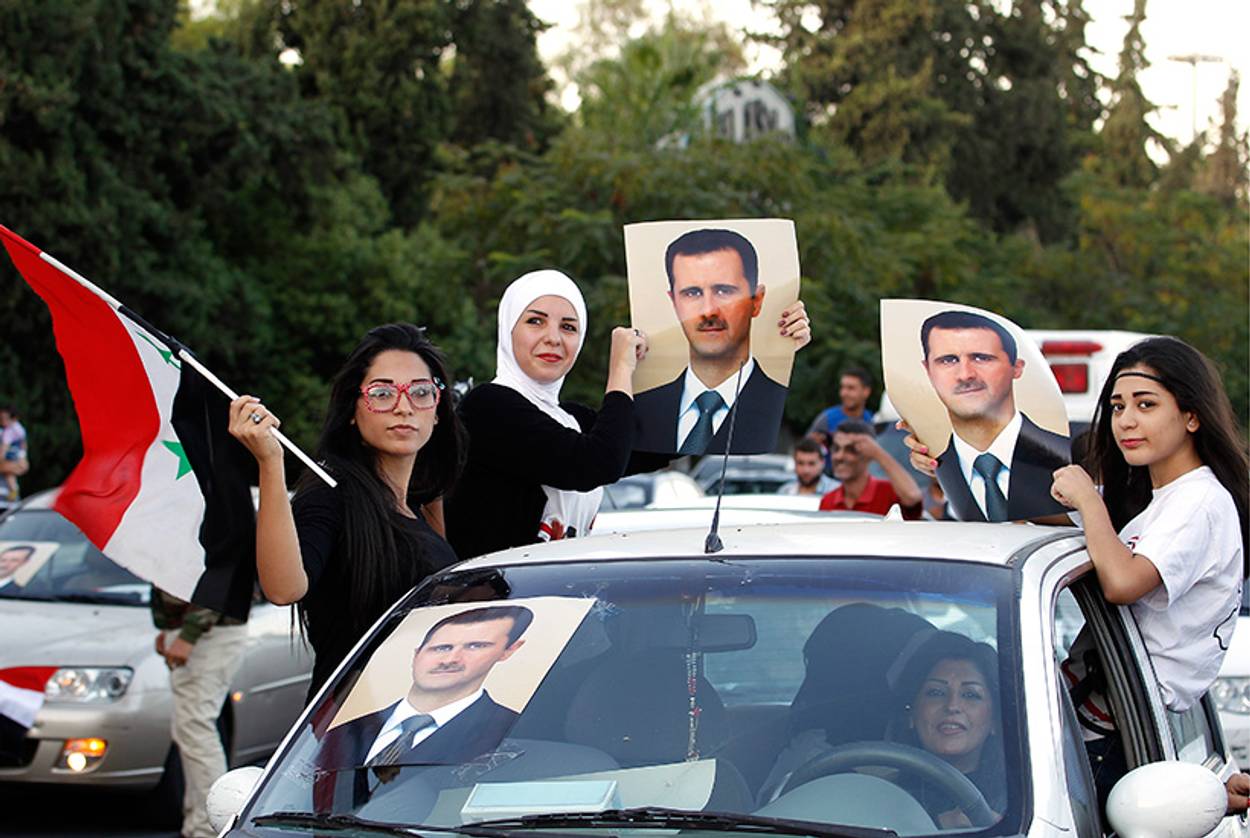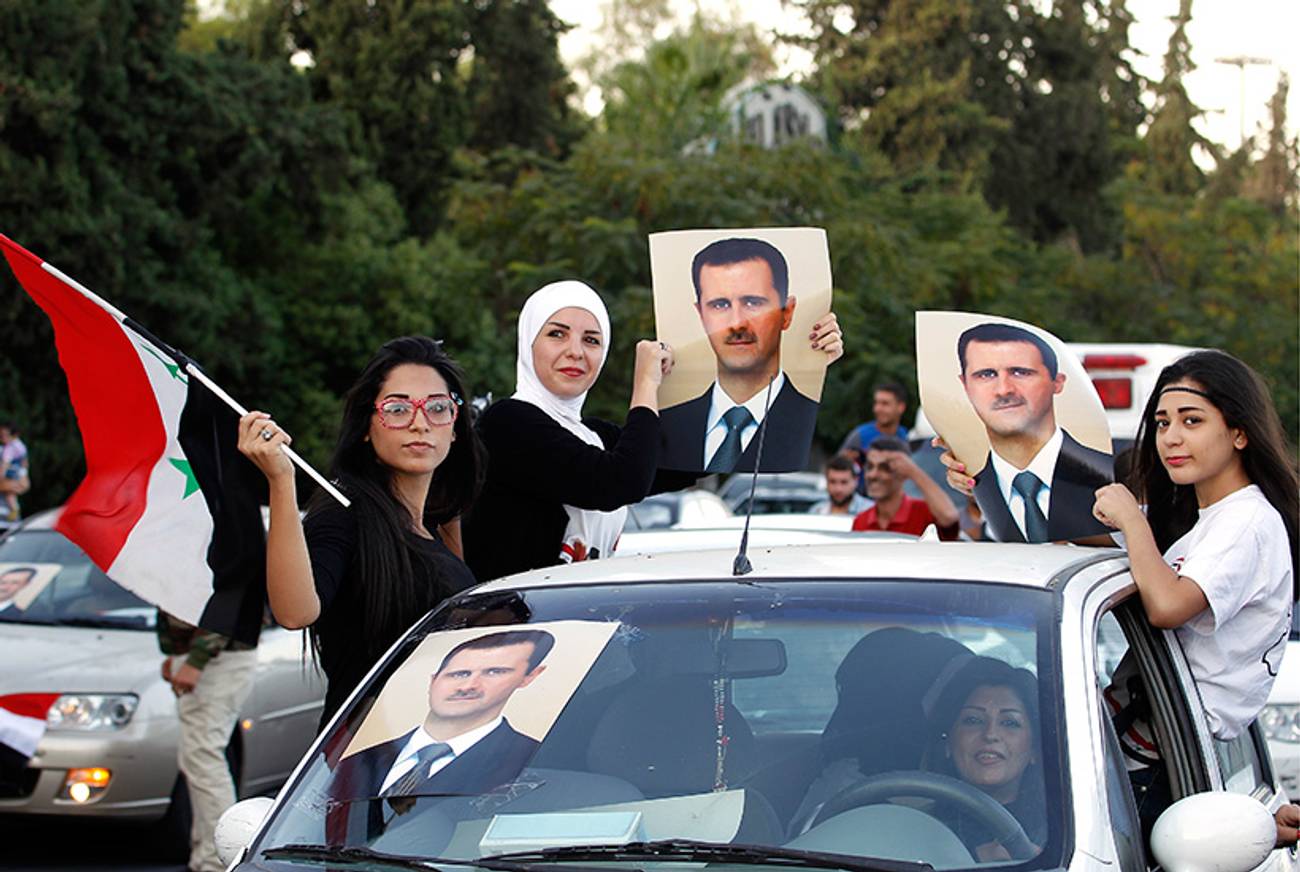With Help From Tehran and Moscow, and Inaction by the U.S., Assad Is Poised To Stay
Thanks to outside forces waging a proxy battle in Syria, 2013 has become a year of attrition rather than endgames




As the Syrian civil war grinds on toward its fourth year, no end appears in sight. It is the greatest disaster in the Levant in a generation: More than 115,000 people have died. Around 2 million refugees have departed the country—for Jordan, Lebanon, Turkey, and beyond—while untold more who have left their homes remain in Syria, seeking with increasing desperation to put themselves and their families out of reach of the guns.
But while the war appears far from ending, its direction and likely outcome have shifted significantly in the past year. At the beginning of this year, the Assad regime looked beleaguered, with an end-game fast approaching. Rebel groups had entered the main cities, and Aleppo, the “capital of the north,” was largely in rebel hands. The battle for Damascus seemed about to begin as Assad’s foes pushed into the city’s eastern suburbs.
Today, as 2013 draws to a close, the situation looks very different. Bashar al-Assad is still in power and has succeeded in ending any immediate threat to his regime. He is no longer in control of the entirety of Syria—his overstretched forces have ceded around half the country’s territory, concentrating their strength in this region around the capital, the Alawite heartland of the western coast, and the area linking the two—but that was never the issue at stake this year. The question was whether the rebels would succeed in pushing into areas of regime control. They have not and are unlikely to in the immediate future. Indeed, rebel advances have ceased, and in some areas, the insurgents have been turned back. The lines between the two sides are largely static, although the daily death toll continues to mount.
The factors driving this new war of attrition derive from both the weakness and disorganization of the rebels, and the relative cohesion of the regime, in particular from the staunch assistance of its regional and global allies and backers, who have come together in unprecedented ways in the course of the last 18 months in order to prevent his downfall. Russia has continued to supply arms to the regime, and its veto power on the U.N. Security Council has prevented any coherent international response to the crisis. But it is Iran that has played the really crucial role in propping up the government. The Syrian central bank has announced that Iran has facilitated a credit line worth at least $4 billion to Assad. One Arab official estimated that Iran was providing around $700 million per month to Syria.
Meantime, the rebellion itself has fallen into disunity, muddying what was once a clear fight between a brutally oppressive, dictatorial regime and an apparently concerted rebellion against it. A local al-Qaida franchise, the Islamic State in Iraq and Syria (ISIS), is clashing with less extreme Islamist groups, such as the Ahfad al-Rasoul Brigade. ISIS has proven itself one of the most effective of the Syrian rebel brigades in combat. It now administers major parts of rebel-held northern Syria. Its area of control includes the city of Raqqa, the only provincial capital to fall to the rebellion—but its extremist Islamist outlook has alienated many among the populace.
The clash between ISIS and the non-al-Qaida Islamist forces is only a symptom of a larger malaise affecting the rebellion—its chronic inability to unify its ranks. There are, according to Charles Lister of Jane’s Information Group, now about a thousand separate rebel groupings or “brigades.” For an insurgency numbering at most around 100,000 fighters, this is an astonishing number. These brigades do not all operate entirely independently from one another. Rather, they are gathered into a bewildering and interlocking series of alliances.
The rebel-controlled area remains a patchwork of different fiefdoms of varying degrees of size and cohesion, each ruled over by a different rebel chieftain and militia. In addition to the fighting between ISIS and less extreme rebel groups, a second war within a war has erupted, this one between the Islamists and the Kurdish YPG militia, which controls a section of northeast Syria comprising around 10 percent of the country’s territory.
The United States attempted to rationalize this situation by supporting the Supreme Military Council of Maj. Gen. Salim Idris, chief of staff for the Free Syrian Army. That initiative may now be judged to have failed. Still more glaring is the failure of the Western-backed Syrian National Coalition, to which Idris’ SMC was affiliated, to have any impact on events within the country.
The external leadership had a problem from the start in claiming the loyalty of fighting units within Syria to which it could offer little or nothing. In my many conversations with rebel fighters and opposition activists during my reporting trips into Syria, I never once heard a single positive or even non-mocking word regarding the external ‘leadership’ of the revolution. A commander of the Tawheed Brigade in Aleppo in the summer of 2012 expressed it most succinctly when he said that the Syrian revolution “would be led by those fighting and suffering within Syria, not those in hotels outside of it.”
The absence of rebel unity and leadership has been a huge boon for Assad. It has been compounded, and partly caused, by the failure of the rebellion’s backers to offer it adequate support. American policy specifically and Western policy more generally toward the Syrian rebellion has proceeded erratically, in fits and starts. Both political and practical assistance have been late in coming and meager in nature.
It was only after five months of rebellion that the United States even called for Assad to stand down, in August 2011. Since then, small numbers of rebels have been offered training on Jordanian soil, and some equipment, most of it nonlethal, has been supplied. But the Obama Administration’s decision in September, after two weeks of very public back and forth, to balk at using force against the regime over Assad’s use of chemical weapons confirmed for both sides that no serious Western aid to the rebels would be forthcoming. This is now an operating assumption for both Assad and his rebel opponents.
In the absence of effective American leadership, the assistance that has reached the rebels has been piecemeal in nature and has helped to exacerbate the problem of rebel disunity, rather than create any threat to the Assad regime. Instead, a variety of different and sometimes opposing networks of support have emerged, supported by a number of different states, without effective coordination and sometimes in direct opposition to one another. The vacuum of Western sponsorship and assistance has also exacerbated the Sunni Islamist takeover of the rebellion, which is now almost complete—which in turn has produced sectarian atrocities, further weakening public support for the rebellion.
So, Assad has been lucky in his choice of enemies. He has, of course, also been lucky in his choice of friends. For the Iranians, saving Assad is not a matter of charity and altruism. Syria forms an essential link in Iran’s goal of consolidating a contiguous line of pro-Iranian Shia states stretching from the country’s own western border across Iraq, Syria, and Lebanon to the Mediterranean coast. If Assad were to fall, that dream is over, and Hezbollah, Iran’s main Arab proxy, would be left isolated. The Iranians are determined to prevent that, and in the course of this year they have succeeded dramatically.
It is in the prosecution of the war itself that Iran’s assistance has been most intriguing and most telling. The Iranians understood early on that Assad’s Achilles heel was his lack of trustworthy men willing to engage on his behalf. While on paper the Syrian dictator possesses an enormous conventional army, large parts of this force are Sunni conscripts who cannot be relied upon to support Assad’s continued rule. In the course of the latter part of 2012, the Iranians, together with their Hezbollah proxies, set about creating an alternative army for their Syrian friend. Today, the National Defense Forces are 50,000 strong and play an important role on the battlefield. In addition, Hezbollah fighters are in Syria, around 10,000 of them earlier in 2013, according to Israeli estimates, though the number has now been somewhat reduced. They have played a vital role in keeping the links between Damascus and the regime’s heartland on the western coastal area open. The Iranians have mobilized additional regional proxies on Assad’s behalf. The Iraqi Abu Fadl al-Abbas Brigade has sent Shia volunteers into Syria. And of course, Iranian Revolutionary Guards personnel are themselves present in Syria and have taken part in the fighting.
The efficient division of labor between Russian arms provision and diplomatic support and Iranian financial assistance, strategic advice, and training and provision of fighters enabled Assad to halt and turn back the rebel advances of late 2012. But Assad may well have paid a price for this assistance: Arguably, he is no longer the undisputed master even of the 40 percent or so of the country that remains under government control. Some reports have suggested that Qassem Suleimani of the Iranian Quds Force is the real “director” of the regime’s war in Syria today, not Bashar Assad.
While that is probably an exaggeration, it is striking that the coalition of forces now gathered to defend the dictatorship in some ways resembles an insurgency, involving militias, hastily assembled volunteer forces, and foreign advisers—no less than does the rebel side. The difference is that whereas the rebel side has only lukewarm and poorly organized assistance from outside and lacks internal unity, the government side is united, well financed, well armed, and committed to a clear goal.
All this raises the question as to whether Assad now has a chance of re-conquering those areas of the country that he ceded in the course of 2012. This is certainly his intention. But there are few signs yet that he is in a position to begin to implement it in a serious way. In the recent fighting, the regime has made some small gains. In the Aleppo region, army base 80 and the town of Sfeira have been recaptured. The rebels are being pushed back around Damascus. But nothing has yet happened to indicate a major shift away from the stalemate.
So, it is likely that Syria is in for a long period of de facto partition and continued conflict. As long as that lasts, Assad will look back on 2013 with a sense of gratitude and pleasure. So far, at least, it has been the year in which the rebellion against him foundered, and the dictator, using means entirely devoid of any noticeable moral compass but with a great deal of strategic and tactical logic, was able to halt the advance against him and consolidate his position—with a lot of help, of course, from his friends.
***
Like this article? Sign up for our Daily Digest to get Tablet Magazine’s new content in your inbox each morning.
Jonathan Spyer is a senior research fellow at the Global Research in International Affairs Center, a fellow at the Middle East Forum, and a columnist at the Jerusalem Post. He is the author of The Transforming Fire: The Rise of the Israel-Islamist Conflict.
Jonathan Spyer is a senior research fellow at the Global Research in International Affairs Center, a fellow at the Middle East Forum, and a columnist at the Jerusalem Post. He is the author of The Transforming Fire: The Rise of the Israel-Islamist Conflict.